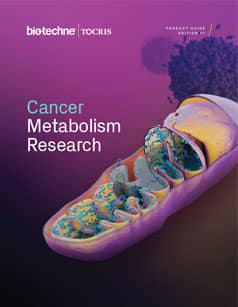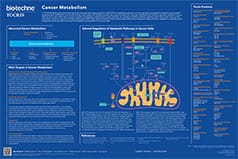Na+/H+ Exchanger
Sodium-hydrogen exchangers (Na+/H+ exchangers, NHE) are ATP-independent membrane glycoprotein transporters that are involved in the regulation of intracellular pH, cell volume and the cellular response to hormones and mitogens.
Na+/H+ Exchanger Inhibitors |
|
|---|---|
| Cat. No. | Product Name / Activity |
| 0890 | Amiloride hydrochloride |
| Na+ channel blocker; inhibits NHE1 | |
| 5512 | BIX NHE1 inhibitor |
| Potent and selective NHE1 inhibitor | |
| 5358 | Cariporide |
| Selective NHE1 inhibitor; cardioprotective and antitumor | |
| 3378 | EIPA |
| Inhibits TRPP3-mediated currents; also inhibits the Na+/H+ exchanger (NHE) | |
| 2727 | Zoniporide dihydrochloride |
| Selective NHE1 inhibitor | |
Sodium-hydrogen exchangers (Na+/H+ exchangers, NHE) are ATP-independent membrane glycoprotein transporters that are involved in the regulation of intracellular pH, cell volume and the cellular response to hormones and mitogens. The transporters mediate the simultaneous efflux of a hydrogen ion and the influx of a sodium ion across the plasma membrane, the driving force being the inwardly directed electrochemical Na+ gradient. There are nine known mammalian NHE isoforms (NHE1-9), all of which differ in specific biological function as well as subcellular localization.
NHE1, the most well characterized NHE isoform, mediates transepithelial transport in secretory parotid acinar cells and may also mediate ammonium reabsorption in the kidney. NHE2 is also expressed in the parotid gland, where it regulates Na+ secretion in addition to its involvement in NaHCO3 absorption in the kidney. Unlike the other NHE isoforms, NHE3 is recycled between apical membranes and the endosomal compartment of epithelial cells where it has a significant involvement in renal and intestinal Na+ absorption. Aside from their roles in regulating intracellular pH and volume, little is known about further functions of NHE4, NHE5, NHE6, NHE7, NHE8 and NHE9.
In addition to their integral involvement in the control of intracellular pH and volume, the NHE family has also been implicated in diseases including hypertension and organ ischemia. Transgenic NHE1 overexpression results in salt-sensitive hypertension in rodents, whilst NHE1 activity in peripheral blood mononuclear cells (PBMCs) from hypertensive patients is directly correlated with increased blood pressure. Whilst the exact mechanism by which NHE activity influences blood pressure remains unknown, it has been suggested to involve the reversal of the Na+/Ca2+ exchanger (NCX); this leads to increased intracellular Ca2+ concentration, driving vascular smooth muscle cell contraction.
The involvement of NHE activity during organ ischemia is complex: H+ efflux driven by the NHE corrects the drop in intracellular pH, yet the concurrent influx of Na+ ions leads to Ca2+ overload through the actions of the NCX. Increased intracellular calcium leads to tissue damage through mechanisms of cellular necrosis and apoptosis that include the opening of the mitochondrial permeability transition pore (MPTP). This paradox, known as the pH paradox, is the driving mechanism behind reperfusion injury following cardiac, renal or cerebral ischemia. In support of the integral involvement of NHE activity during organ ischemia, NHE1 inhibition has been shown to exert a protective effect during cardiac ischemia.
External sources of pharmacological information for Na+/H+ Exchanger :
Literature for Na+/H+ Exchanger
Tocris offers the following scientific literature for Na+/H+ Exchanger to showcase our products. We invite you to request* your copy today!
*Please note that Tocris will only send literature to established scientific business / institute addresses.
Cancer Metabolism Research Product Guide
This product guide reviews some of the main areas in cancer metabolism research and lists around 150 products that can be used to investigate metabolic pathways in cancer including:
- Glycolysis
- Tricarboxylic Acid Cycle
- Lipidogenesis
- 1C Metabolism and Nucleic Acid Synthesis
- Drivers of Metabolic Reprogramming
- pH and Redox Balance
Cancer Metabolism Poster
This poster summarizes the main metabolic pathways in cancer cells and highlights potential targets for cancer therapeutics. Genetic changes and epigenetic modifications in cancer cells alter the regulation of cellular metabolic pathways providing potential cancer therapeutic targets.
Na+/H+ Exchanger Gene Data
| Gene | Species | Gene Symbol | Gene Accession No. | Protein Accession No. |
|---|---|---|---|---|
| Solute carrier family 9, subfamily A member 1 (NHE1) | Human | SLC9A1 | NM_003047 | P19634 |
| Mouse | Slc9a1 | NM_016981 | Q61165 | |
| Rat | Slc9a1 | NM_012652 | P26431 | |
| Solute carrier family 9, subfamily A member 2 (NHE2) | Human | SLC9A2 | NM_003048 | Q9UBY0 |
| Mouse | Slc9a2 | NM_001033289 | Q3ZAS0 | |
| Rat | Slc9a2 | NM_012653 | P48763 | |
| Solute carrier family 9, subfamily A member 3 (NHE3) | Human | SLC9A3 | NM_004174 | P48764 |
| Mouse | Slc9a3 | NM_001081060 | G3X939 | |
| Rat | Slc9a3 | NM_012654 | P26433 | |
| Solute carrier family 9, subfamily A member 4 (NHE4) | Human | SLC9A4 | NM_001011552.3 | Q6AI14 |
| Mouse | Slc9a4 | NM_177084 | Q8BUE1 | |
| Rat | Slc9a4 | NM_173098 | P26434 | |
| Solute carrier family 9, subfamily A member 5 (NHE5) | Human | SLC9A5 | NM_004594 | Q14940 |
| Mouse | Slc9a5 | NM_001081332 | B2RXE2 | |
| Rat | Slc9a5 | NM_138858 | Q9Z0X2 | |
| Solute carrier family 9, subfamily A member 6 (NHE6) | Human | SLC9A6 | NM_006359 | Q92581 |
| Mouse | Slc9a6 | NM_172780 | A1L3P4 | |
| Rat | Slc9a6 | XM_001053956 | D3ZWQ4 | |
| Solute carrier family 9, subfamily A member 7 (NHE7) | Human | SLC9A7 | NM_032591 | Q96T83 |
| Mouse | Slc9a7 | NM_177353 | Q8BLV3 | |
| Rat | - | - | - | |
| Solute carrier family 9, subfamily A member 8 (NHE8) | Human | SLC9A8 | XM_030524 | Q9Y2E8 |
| Mouse | Slc9a8 | NM_148929 | Q8R4D1 | |
| Rat | Slc9a8 | NM_001025281 | Q4L208 | |
| Solute carrier family 9, subfamily A member 9 (NHE9) | Human | SLC9A9 | NM_173653 | Q8IVB4 |
| Mouse | Slc9a9 | NM_177909 | Q8BZ00 | |
| Rat | Slc9a9 | XM_001064905 | - |

